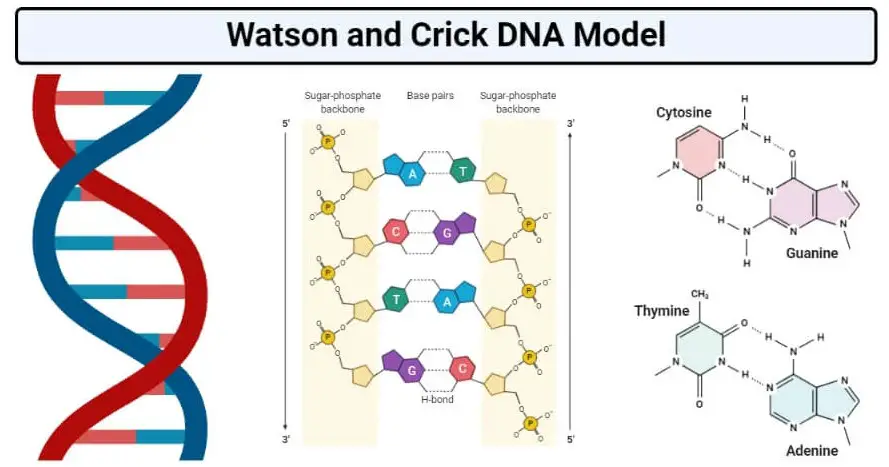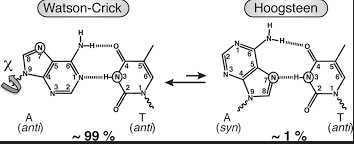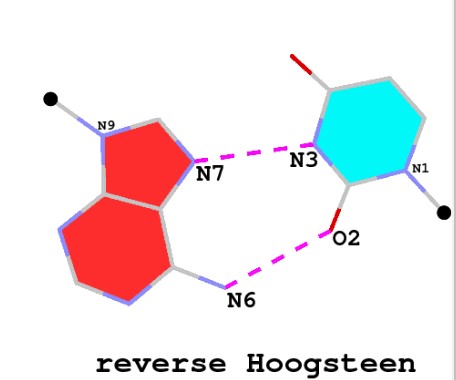DNA is the fundamental blueprint of life, encoding the genetic instructions essential for the development and functioning of all known organisms. The structure of DNA is complex, with its stability and functionality dependent on the precise pairing of its bases. Two types of base pairing crucial for understanding DNA’s molecular configuration are Watson and Crick and Hoogsteen base pairing. Each type plays a vital role in the overall architecture and function of DNA, but they differ in their formation and implications.
Watson and Crick base pairing is the classic model of DNA structure, where adenine pairs with thymine, and cytosine pairs with guanine through hydrogen bonds. In contrast, Hoogsteen base pairing involves a different hydrogen bonding pattern, where bases rotate to form alternative pairing configurations under specific conditions. This secondary structure can affect DNA’s physical properties and its interaction with various proteins.
The distinction between Watson and Crick and Hoogsteen base pairing provides profound insights into DNA’s versatility and adaptability. While the former is predominant under normal physiological conditions, the latter can occur during DNA’s interaction with proteins and under altered chemical states, highlighting the dynamic nature of genetic encoding and its capability to adapt to different cellular environments.

Base Pairing Basics
DNA, the molecule that carries the genetic instructions for life, has its structure determined by the specific ways in which its bases pair up. The concept of base pairing is central to the replication of DNA and its functional roles in cells. Two models describe these interactions: the Watson and Crick model and the Hoogsteen base pairing.
Watson and Crick Model
Historical Discovery
In 1953, James Watson and Francis Crick proposed the double helix model of DNA, revolutionizing our understanding of genetic material. Their model was based on the X-ray diffraction images produced by Rosalind Franklin, providing crucial insights into the helical structure of DNA. This model elucidated how DNA replicates and how genetic instructions are coded on the molecule.
A-T and G-C Pairings
The Watson and Crick model of DNA is characterized by specific pairings: adenine (A) pairs with thymine (T), and guanine (G) pairs with cytosine (C). These pairs are stabilized by hydrogen bonds; A-T pairs form two hydrogen bonds, while G-C pairs form three, providing a stable structure for the DNA double helix.
Hoogsteen Base Pairing
Discovery Context
Discovered by Karst Hoogsteen in 1959, Hoogsteen base pairing offered an alternate view of how nucleotide bases could interact. Found under certain chemical conditions or when DNA is bound to proteins, this form of base pairing provides flexibility and complexity to DNA structure and its biological functions.
Alternate Pairing Mechanisms
Unlike the Watson and Crick model, Hoogsteen base pairing involves a shift in the hydrogen bonding face of the bases. Adenine, for instance, can bind to thymine in a way that uses a different set of donor and acceptor groups, forming what is known as a Hoogsteen pair. This mechanism is often induced by the presence of proteins or by modifications to the bases themselves, such as methylation.
Structural Differences
Molecular Arrangements
The molecular arrangement in Watson and Crick base pairing is straightforward with bases aligning directly across from each other. In contrast, Hoogsteen base pairing often sees a rotation or a tilt in the base alignment, affecting the overall geometry of the DNA helix.
Bond Angles and Hydrogen Bonds
In Hoogsteen base pairing, the bond angles and the positioning of hydrogen bonds differ significantly from the traditional Watson and Crick model. These changes can influence the physical properties of the DNA molecule, such as its flexibility and the width of the helix.
Nucleotide Positioning
Nucleotide positioning also varies, with the Hoogsteen model allowing for a more relaxed helix structure where nucleotides can shift position relative to each other. This flexibility can be critical in how DNA interacts with proteins and other molecules.
Stability Factors
Environmental Conditions
Environmental factors such as pH and ionic strength influence which type of base pairing prevails. Hoogsteen base pairing tends to occur under acidic conditions or in environments rich in certain metallic ions.
Chemical Influences
Chemical modifications to bases, such as methylation, can promote the formation of Hoogsteen pairs. These chemical changes can affect the stability and regulatory functions of genes.
Functional Implications
Genetic Information Encoding
The type of base pairing can impact how genetic information is encoded and subsequently read during transcription. Variations in base pairing can lead to mutations or to subtle variations in how proteins are produced.
Impact on Transcription
Transcription fidelity can be affected by which type of base pairing dominates. Hoogsteen base pairing, occurring transiently, might alter the way RNA polymerase reads DNA.
Mutations and Variations
Mutations in DNA can result from mismatches or shifts in base pairing norms. Understanding these variations helps in studying genetic diseases and anomalies.
Biological Processes
DNA Replication Relevance
Both types of base pairing play roles during DNA replication, though Watson and Crick’s model is more common. However, the presence of Hoogsteen pairing can influence the efficiency and accuracy of replication under stress conditions.
Role in Genetic Diseases
Certain genetic disorders are linked to mutations that favor Hoogsteen over Watson and Crick base pairing, affecting the stability and functionality of genes. This insight is crucial in understanding and potentially treating such conditions.

Research and Applications
Technological Advancements
Modern Research Techniques
The field of genetic research has seen significant technological advancements in recent years. High-throughput sequencing technologies, such as next-generation sequencing (NGS), allow scientists to observe DNA base pairing, including both Watson and Crick and Hoogsteen interactions, with unprecedented speed and precision. These techniques provide a detailed view of the genetic variations that might not be apparent with older methods. Additionally, advanced imaging techniques like cryo-electron microscopy (cryo-EM) have begun to shed light on the physical structures of DNA in near-atomic detail, allowing for observations of transient base pairing such as Hoogsteen pairs in vivo.
Future Study Directions
The future of DNA base pairing research is likely to focus on integrating these advanced technologies with computational biology to predict and model how DNA structure influences gene expression and stability. Scientists are particularly interested in how environmental factors and chemical modifications influence the prevalence of Hoogsteen base pairing. Ongoing advancements in artificial intelligence and machine learning offer promising tools for predicting the occurrence of base pairing types across different genomic contexts, which could revolutionize our understanding of genetic regulation and mutation.
Practical Uses
Medical Diagnostics
In medical diagnostics, understanding DNA base pairing mechanisms is crucial. For example, certain genetic disorders are characterized by a propensity towards alternative base pairing, which can be identified through genomic sequencing. Detecting these anomalies can lead to early diagnosis and better management of diseases such as cancer, where DNA mutations play a critical role. Techniques that can differentiate between Watson and Crick and Hoogsteen base pairings are particularly valuable in personalized medicine, providing a tailored approach to treatment based on an individual’s genetic makeup.
Therapeutic Developments
In therapeutic development, insights into DNA base pairing are leading to novel strategies for drug design. Drugs that can specifically target and modify DNA interactions, particularly Hoogsteen pairs, are being developed to regulate gene expression in diseases where these pairs are more common. Additionally, gene therapy techniques are improving, with the potential to directly correct genetic defects at the DNA level, offering hope for conditions previously considered untreatable.
Comparison and Contrast
Key Similarities
Fundamental Roles in DNA
Both Watson and Crick and Hoogsteen base pairing play fundamental roles in the structure and function of DNA. They are essential for the storage of genetic information, ensuring that DNA can be accurately copied and transcribed into RNA, which is crucial for protein synthesis.
Chemical Components
At the chemical level, both types of base pairing involve adenine, thymine, cytosine, and guanine. The primary interactions in these pairings are hydrogen bonds, which are critical for maintaining the stability and integrity of the DNA double helix.
Critical Differences
Structural Configuration
The structural configuration of DNA differs significantly between Watson and Crick and Hoogsteen base pairing. Watson and Crick base pairs are more symmetric and occur under normal physiological conditions, providing a stable and predictable double helix structure. In contrast, Hoogsteen base pairs are often less symmetric and can introduce a twist or distortion in the DNA strand, which may affect the helix’s stability and accessibility.
Biological Significance
The biological significance of these differences is profound. Watson and Crick base pairing is essential for normal cellular function and genetic integrity. In contrast, Hoogsteen base pairing, while less common, plays a critical role under specific conditions, such as in the presence of proteins or during significant stress, affecting gene regulation and the cellular response to environmental changes. This adaptability may also contribute to the evolution of new genetic traits and variations, highlighting its potential significance in evolutionary biology.
Frequently Asked Questions
What is Watson and Crick base pairing?
Watson and Crick base pairing refers to the traditional model of DNA structure discovered in 1953. This model outlines that adenine (A) pairs with thymine (T) and cytosine (C) pairs with guanine (G) through specific hydrogen bonds, forming a stable double helix structure.
How does Hoogsteen base pairing differ?
Hoogsteen base pairing allows for alternative bonding configurations in DNA, where the bases rotate to expose different edges for hydrogen bonding. This occurs under special conditions such as high protein concentrations or acidic pH, providing a secondary structure within the DNA helix.
Why is understanding different base pairings important?
Understanding the variations in DNA base pairing is crucial for insights into genetic mutations, DNA repair mechanisms, and the overall stability of the genetic code. It aids in advancing medical research, particularly in areas like genetic disorders and cancer.
Can Hoogsteen base pairing affect genetic expression?
Yes, Hoogsteen base pairing can influence genetic expression by altering the physical structure of DNA. This alteration can affect how DNA interacts with various regulatory proteins, potentially leading to changes in gene expression and implications for cellular function and disease.
Conclusion
The study of Watson and Crick and Hoogsteen base pairings underscores the complex and dynamic nature of DNA. These interactions are not merely mechanical but are crucial for the adaptive responses of DNA to various cellular conditions, influencing genetic stability and expression. By exploring these foundational concepts, researchers continue to unravel the intricate mechanisms of genetic regulation and mutation.
Advancements in understanding these base pairing mechanisms have profound implications for medical science, particularly in the realms of genetic engineering and personalized medicine. As research progresses, the potential to manipulate these interactions could lead to breakthroughs in treating genetic disorders and enhancing biological understanding at the molecular level.

